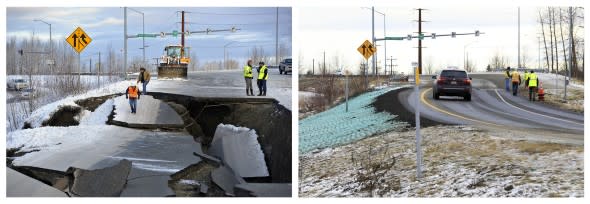How were roads in Alaska repaired so quickly after the earthquake?

This combination photo shows a part of Minnesota Drive, left, that collapsed after an earthquake in Anchorage, Alaska, on Nov. 30, 2018, and the same part of the road after it was repaired on Dec. 5. The collapsed off-ramp in Alaska's largest city after the destructive force of a magnitude 7.0 earthquake was rebuilt and reopened four days after its destruction. (AP Photo/Dan Joling, Mike Dinneen, File)
Winter infrastructure repairs and long-range construction projects are difficult to plan around Alaska's unique weather conditions and lack of daylight. And that's without an earthquake.
But on Dec. 1, the city of Anchorage was struck by a monstrous 7.0 magnitude quake that crumbled major roadways. Cars were left stranded, buildings were rocked and bridges were damaged.
With the severity of the destruction and unobliging weather of Anchorage winters, it was reasonable to believe that the repairs would take weeks, if not months, to complete. Instead, the roads were repaved, repaired and reopened in just a few days.
While the city was in the midst of a warmer spell at the time of the earthquake, the temperatures in the week following were consistently below freezing. Average temperatures for December in Anchorage range from 13 to 25 F degrees while residents are granted less than six hours of sunlight.

In this Friday, Nov. 30, 2018 file photo, a vehicle is trapped on a section of road that collapsed during an earthquake in Anchorage, Alaska. The collapsed roadway that became an iconic image of the destructive force of a magnitude 7.0 earthquake and its aftershocks was repaired just days after the quake. The off-ramp connecting Minnesota Drive and a road to Ted Stevens Anchorage International Airport reopened Tuesday, Dec. 4, 2018, with shoulder work finished Wednesday. (AP Photo/Dan Joling, File )
But to Shannon McCarthy, the media liaison of the Alaska Department of Transportation, the preparation and hard work of the asphalt producers and the paving crews made all the difference in completing the repairs in just four days.
"Cold temperatures were a huge challenge for paving," McCarthy told AccuWeather. "All of our asphalt plants were shut down for the winter. Our staff contacted our local asphalt producer about two hours after the quake to ask them about restarting the plants, and they did so immediately. It's incredible that they were able to bring them back on line as quickly as they did."
McCarthy also said that there were eight major breaks in infrastructure from the earthquake. One of the most significant issues came from the collapse of the off-ramp by the Anchorage Airport.
While the daylight and temperatures certainly were not ideal for the repair efforts, McCarthy told AccuWeather there was another weather impact that actually made the work more difficult for crews.
"Construction crews brought in lights; they worked 24//7 to make the repairs," she said. "We had a combination of weather and some snow, but the hardest condition was actually the freezing rain. They just pushed through the weather, not ideal but the workers came prepared."
Many of the repairs that were made are considered just temporary, as the frozen soil and cold weather hurts the durability of roadways, according to McCarthy. More permanent repairs will be made at a later time, but for the next few winter months, residents can thank the diligence and quick response of paving crews for getting their city running smoothly once again.
